TOYOTA 4RUNNER 2022 Owners Manual
Manufacturer: TOYOTA, Model Year: 2022, Model line: 4RUNNER, Model: TOYOTA 4RUNNER 2022Pages: 616, PDF Size: 12.01 MB
Page 191 of 616
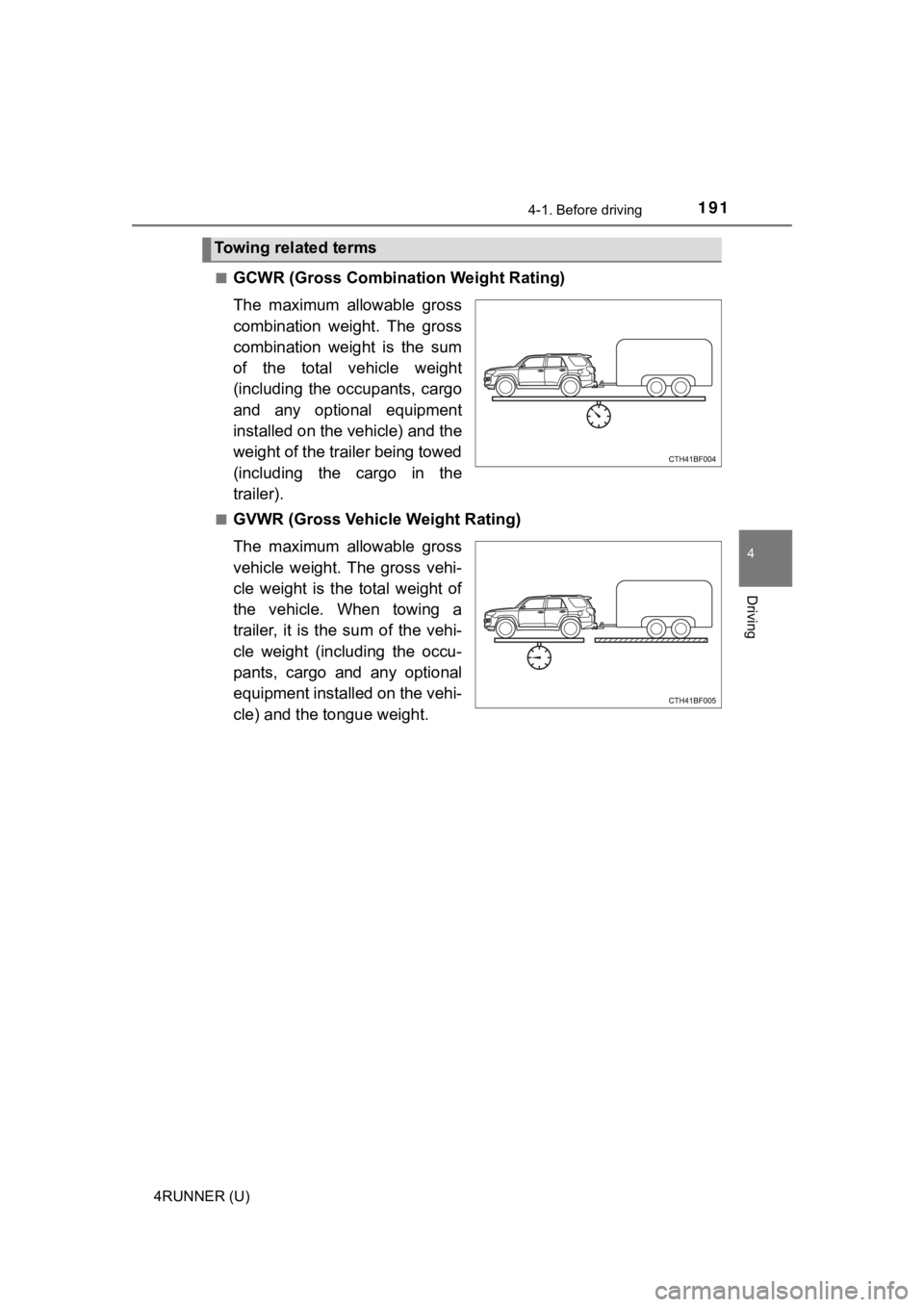
1914-1. Before driving
4
Driving
4RUNNER (U)■
GCWR (Gross Combination Weight Rating)
The maximum allowable gross
combination weight. The gross
combination weight is the sum
of the total vehicle weight
(including the occupants, cargo
and any optional equipment
installed on the vehicle) and the
weight of the trailer being towed
(including the cargo in the
trailer).
■GVWR (Gross Vehicle Weight Rating)
The maximum allowable gross
vehicle weight. The gross vehi-
cle weight is the total weight of
the vehicle. When towing a
trailer, it is the sum of the vehi-
cle weight (including the occu-
pants, cargo and any optional
equipment installed on the vehi-
cle) and the tongue weight.
Towing related terms
Page 192 of 616
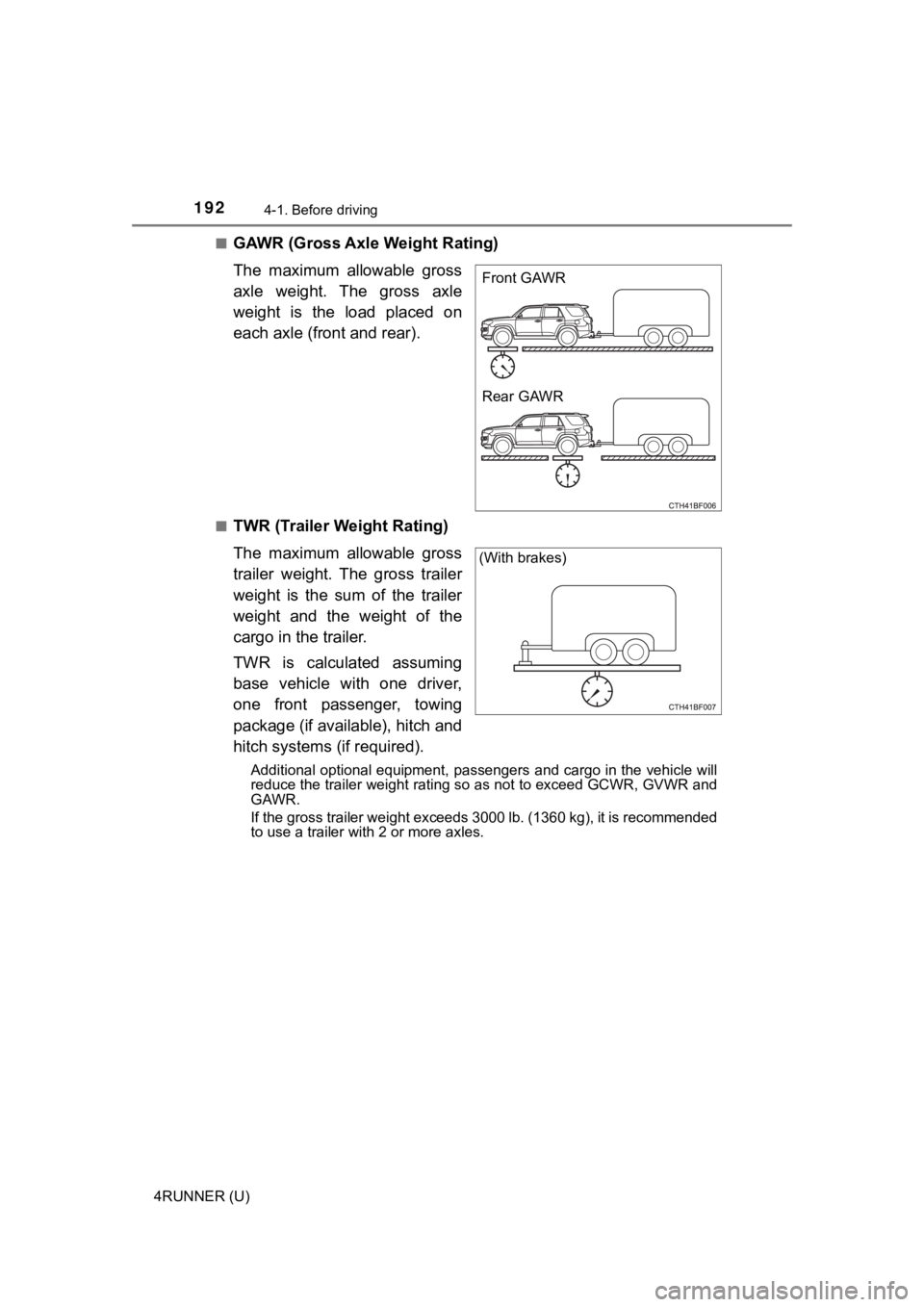
1924-1. Before driving
4RUNNER (U)■
GAWR (Gross Axle Weight Rating)
The maximum allowable gross
axle weight. The gross axle
weight is the load placed on
each axle (front and rear).
■TWR (Trailer Weight Rating)
The maximum allowable gross
trailer weight. The gross trailer
weight is the sum of the trailer
weight and the weight of the
cargo in the trailer.
TWR is calculated assuming
base vehicle with one driver,
one front passenger, towing
package (if available), hitch and
hitch systems (if required).
Additional optional equipment, passengers and cargo in the vehi
cle will
reduce the trailer weight rating so as not to exceed GCWR, GVWR and
GAWR.
If the gross trailer weight exceeds 3000 lb. (1360 kg), it is r ecommended
to use a trailer with 2 or more axles.
Front GAWR
Rear GAWR
(With brakes)
Page 193 of 616
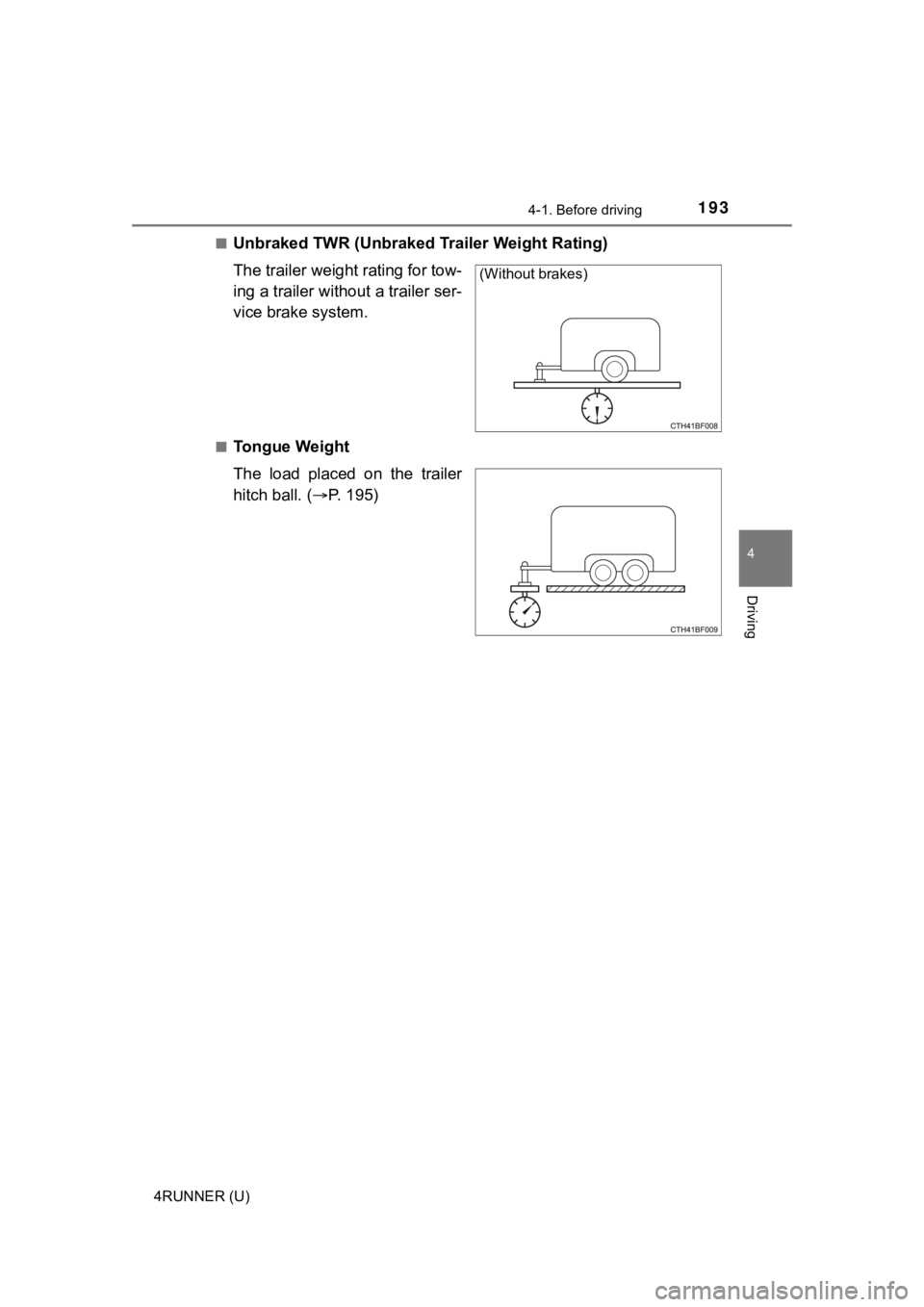
1934-1. Before driving
4
Driving
4RUNNER (U)■
Unbraked TWR (Unbraked Trailer Weight Rating)
The trailer weight rating for tow-
ing a trailer without a trailer ser-
vice brake system.
■Tongue Weight
The load placed on the trailer
hitch ball. (
P. 195)
(Without brakes)
Page 194 of 616
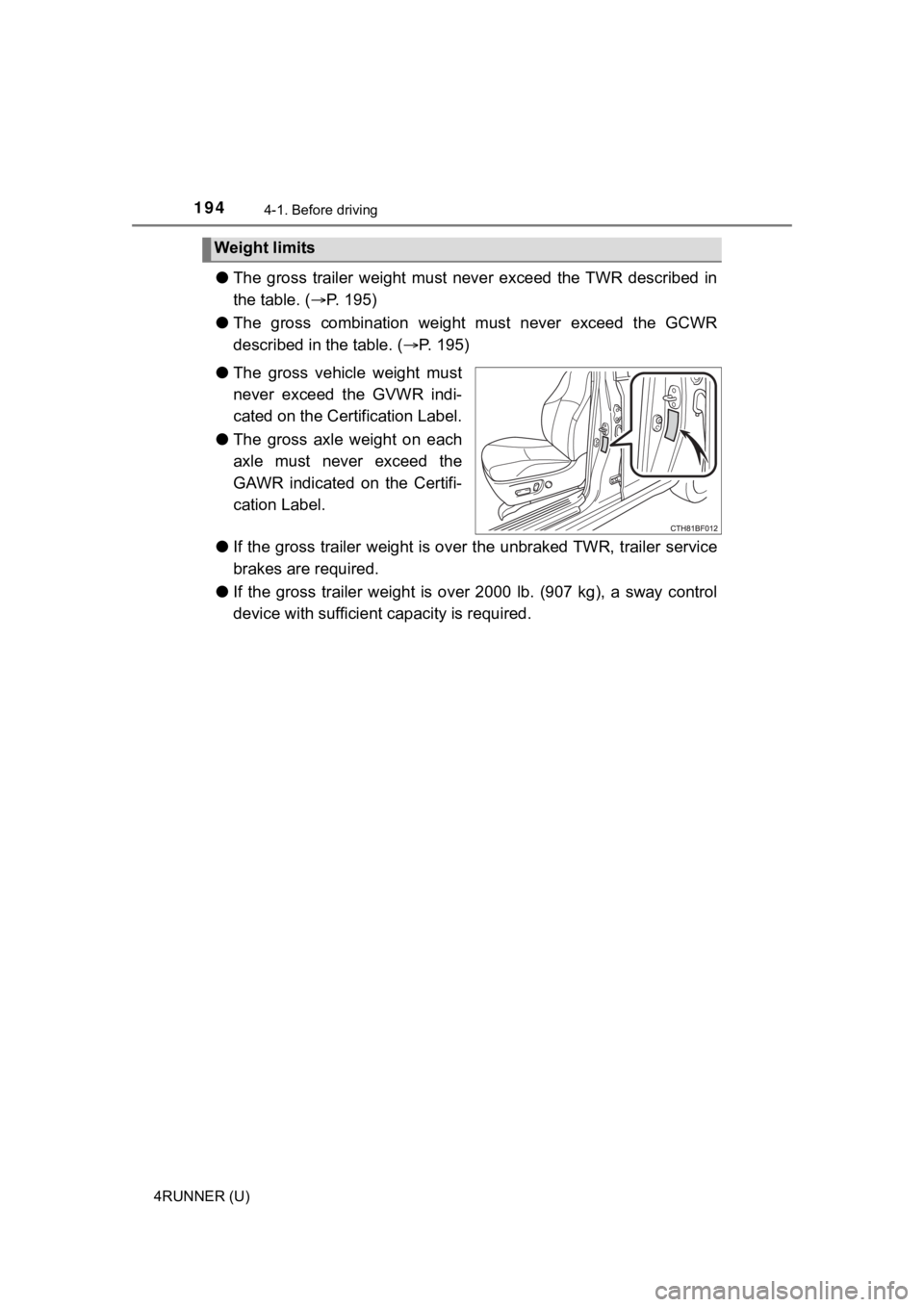
1944-1. Before driving
4RUNNER (U)
●The gross trailer weight must never exceed the TWR described in
the table. ( P. 1 9 5 )
● The gross combination weight must never exceed the GCWR
described in the table. ( P. 1 9 5 )
● The gross vehicle weight must
never exceed the GVWR indi-
cated on the Certification Label.
● The gross axle weight on each
axle must never exceed the
GAWR indicated on the Certifi-
cation Label.
● If the gross trailer weight is over the unbraked TWR, trailer s ervice
brakes are required.
● If the gross trailer weight is over 2000 lb. (907 kg), a sway c ontrol
device with sufficient capacity is required.
Weight limits
Page 195 of 616
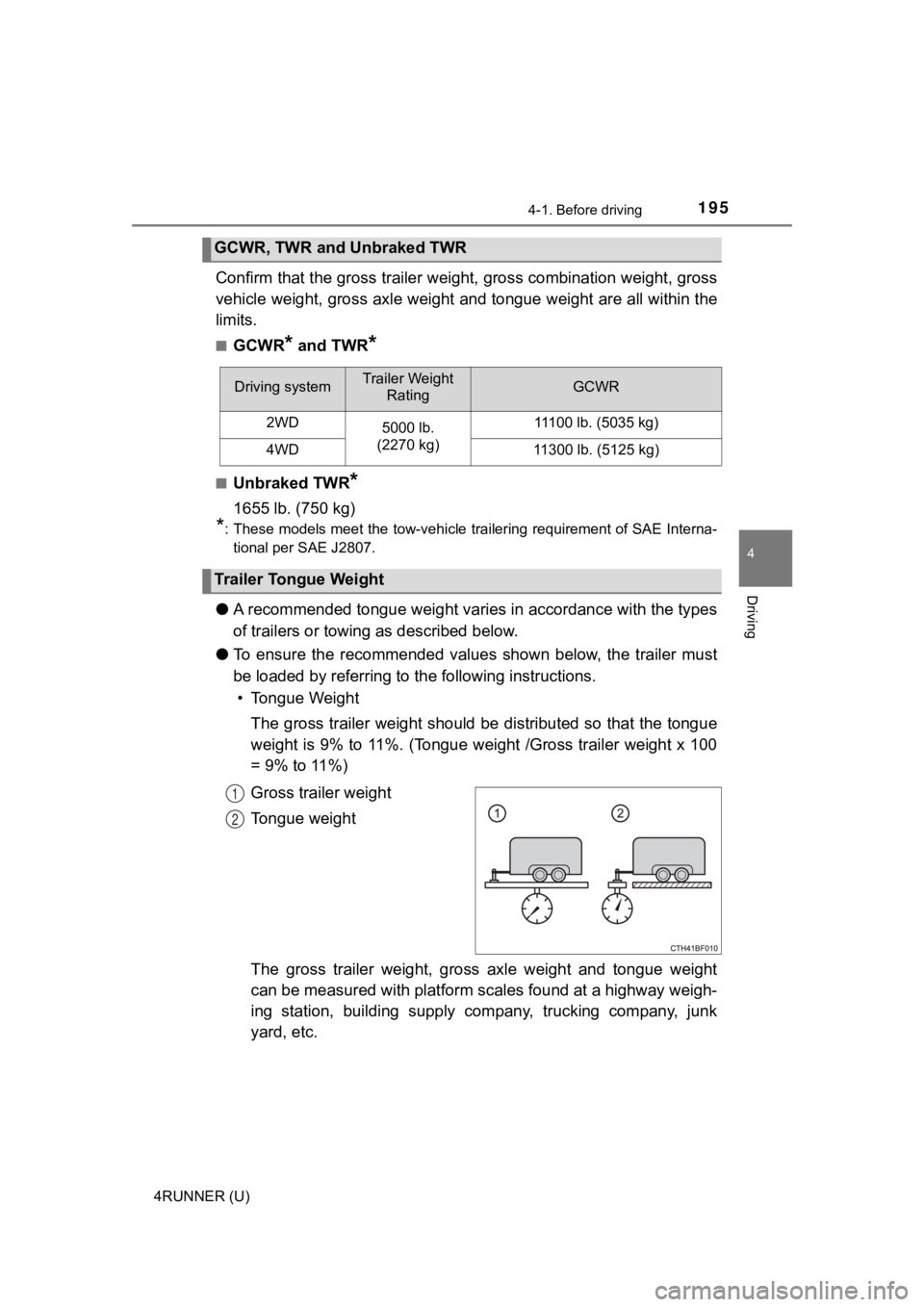
1954-1. Before driving
4
Driving
4RUNNER (U)
Confirm that the gross trailer weight, gross combination weight, gross
vehicle weight, gross axle weight and tongue weight are all within the
limits.
■GCWR* and TWR*
■Unbraked TWR*
1655 lb. (750 kg)
*: These models meet the tow-vehicle trailering requirement of SA E Interna-
tional per SAE J2807.
● A recommended tongue weight varies in accordance with the types
of trailers or towing as described below.
● To ensure the recommended values shown below, the trailer must
be loaded by referring to t he following instructions.
• Tongue Weight
The gross trailer weight should be distributed so that the tong ue
weight is 9% to 11%. (Tongue weight /Gross trailer weight x 100
= 9% to 11%)
Gross trailer weight
Tongue weight
The gross trailer weight, gross axle weight and tongue weight
can be measured with platform sca les found at a highway weigh-
ing station, building supply company, trucking company, junk
yard, etc.
GCWR, TWR and Unbraked TWR
Driving systemTrailer Weight RatingGCWR
2WD 5000 lb.
(2270 kg) 11100 lb. (5035 kg)
4WD11300 lb. (5125 kg)
Trailer Tongue Weight
1
2
Page 196 of 616

1964-1. Before driving
4RUNNER (U)
Trailer hitch assemblies have different weight capacities. Toyota rec-
ommends the use of Toy ota hitch/bracket for your vehicle. For d etails,
contact your Toyota dealer.
● If you wish to install a trailer hitch, contact your Toyota dea ler.
● Use only a hitch that conforms to the gross trailer weight requ ire-
ment of your vehicle.
● Follow the directions suppli ed by the hitch manufacturer.
● Lubricate the hitch ball with a light coating of grease.
● Remove the hitch ball whenever you are not towing a trailer.
Remove the trailer hitch if you do not need it. After removing the
hitch, seal any mounting hole in the vehicle body to prevent en try of
any substances into the vehicle.
Hitch
Page 197 of 616
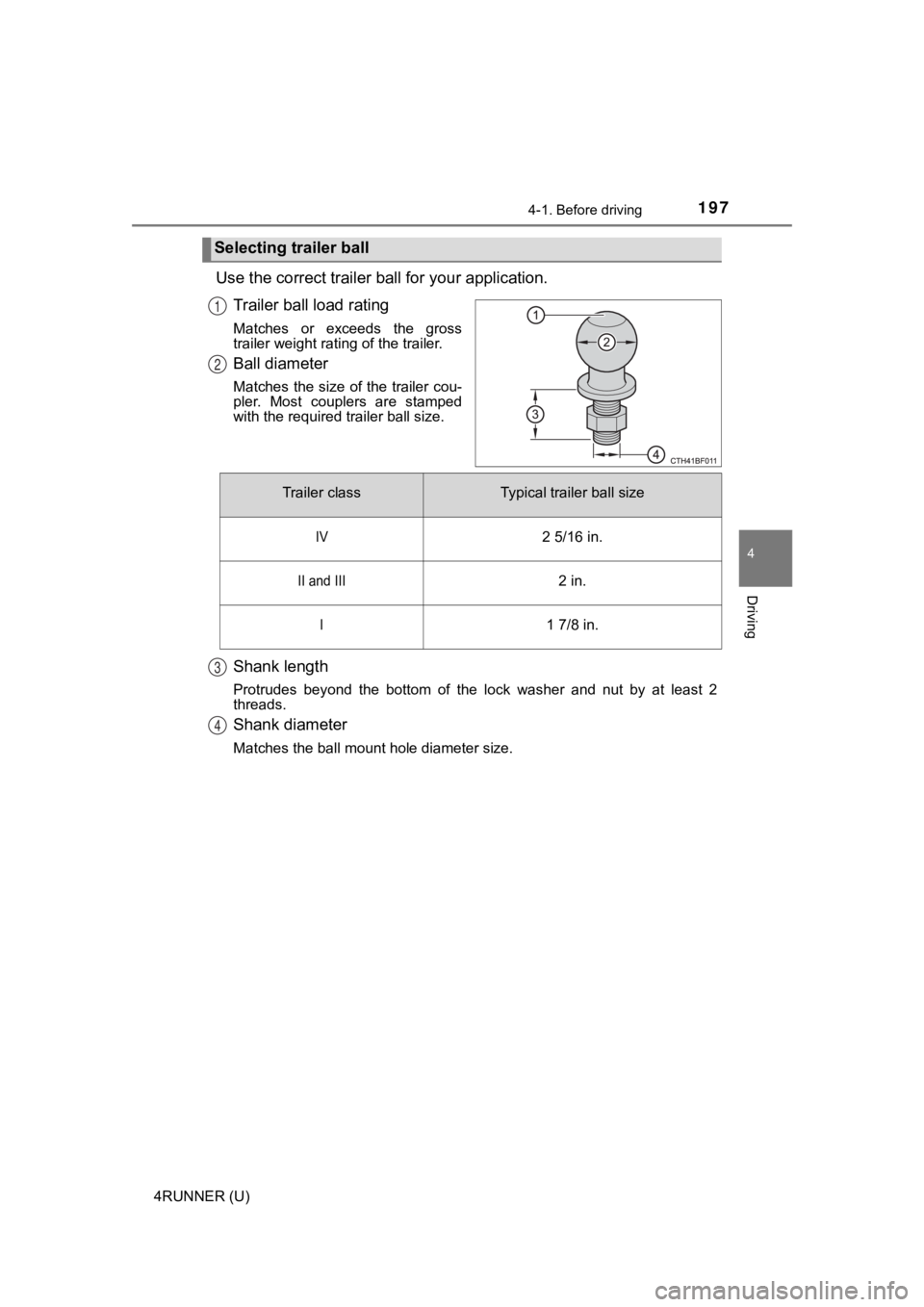
1974-1. Before driving
4
Driving
4RUNNER (U)
Use the correct trailer ball for your application.Trailer ball load rating
Matches or exceeds the gross
trailer weight rating of the trailer.
Ball diameter
Matches the size of the trailer cou-
pler. Most couplers are stamped
with the required trailer ball size.
Shank length
Protrudes beyond the bottom of the lock washer and nut by at le ast 2
threads.
Shank diameter
Matches the ball mount hole diameter size.
Selecting trailer ball
1
2
Trailer classTypical trailer ball size
IV2 5/16 in.
II and III2 in.
I1 7/8 in.
3
4
Page 198 of 616

1984-1. Before driving
4RUNNER (U)
Weight carrying ball position:
50.1 in. (1272 mm)
Hitch receiver pin hole position:
43.7 in. (1109 mm)
Use the wire harness stored in the
rear end under body.
Please consult your dealer when installing trailer lights, as i ncorrect
installation may cause damage to the vehicle’s lights. Please t ake
care to comply with your state’s laws when installing trailer lights.
■Service connector for towing brake controller
Positions for towing hitch receiver and hitch ball
1
2
Connecting trailer lights
Your vehicle is equipped with a service
connector for the trailer brake controller
as shown.
Page 199 of 616

1994-1. Before driving
4
Driving
4RUNNER (U)
Your vehicle will handle differently when towing a trailer. Help to avoid
an accident, death or serious injury, keep the following in min d when
towing:
● Speed limits for towing a trailer vary by state or province. Do not
exceed the posted to wing speed limit.
● Toyota recommends that the vehicl e-trailer speed limit is 65 mph
(104 km/h) on a flat, straight, dry road. Do not exceed this li mit, the
posted towing speed limit or the speed limit for your trailer as set
forth in your trailer owner’s manu al, whichever is lowest. Instability
of the towing vehicle-trailer combination (trailer sway) increa ses as
speed increases. Exceeding speed limits may cause loss of contr ol.
● Before starting out, check the trailer lights, tires and the vehicle-
trailer connections. Recheck af ter driving a short distance.
● Practice turning, stopping and reversing with the trailer attac hed in
an area away from traffic until you become accustomed to the fe el
of the vehicle-trailer combination.
● Reversing with a trailer attached is difficult and requires pra ctice.
Grip the bottom of the steering wheel and move your hand to the
left to move the trailer to the left. Move your hand to the rig ht to
move the trailer to right. (This is generally opposite to reversing
without a trailer attached.) Avoid sharp or prolonged turning. Have
someone guide you when reversing to reduce the risk of an acci-
dent.
● As stopping distance is increased when towing a trailer, vehicl e-to
vehicle distance should be increased. For each 10 mph (16 km/h)
of speed, allow at least one v ehicle and trailer length.
● Avoid sudden braking as you may skid, resulting in the trailer jack-
knifing and a loss of vehicle control. This is especially true on wet or
slippery surfaces.
Trailer towing tips
Page 200 of 616

2004-1. Before driving
4RUNNER (U)
●Avoid jerky starts or sudden acceleration.
● Avoid jerky steering and sharp turns, and slow down before maki ng
turn.
● Note that when making a turn, the trailer wheels will be closer than
the vehicle wheels to the inside of the turn. Compensate by mak ing
a wider than normal turning radius.
● Slow down before making a turn, in cross winds, on wet or slipp ery
surfaces, etc.
Increasing vehicle speed can destabilize the trailer.
● Take care when passing other vehicles. Passing requires consider-
able distance. After passing a vehicle, do not forget the lengt h of
your trailer, and be sure you have plenty of room before changi ng
lanes.
● To maintain engine braking efficiency and charging system perfo r-
mance when using engine braking, do not put the transmission in
D.
● Instability happens more frequently when descending steep or lo ng
downhill grades. Before descending, slow down and downshift. Do
not make sudden downshifts while descending steep or long down-
hill grades.
● Avoid holding the brake pedal down too long or applying the bra kes
too frequently. This could cause the brakes to overheat and result in
reduced braking efficiency.
● Due to the added load of the trailer, your vehicle’s engine may over-
heat on hot days (at temperatures over 85°F [30°C]) when drivin g
up a long or steep grade. If the engine coolant temperature gau ge
indicates overheating, immediately turn off the air conditionin g (if in
use), pull your vehicle off the road and stop in a safe spot.
( P. 527)